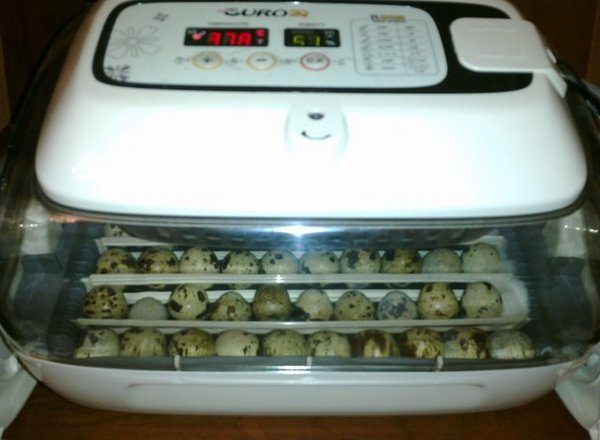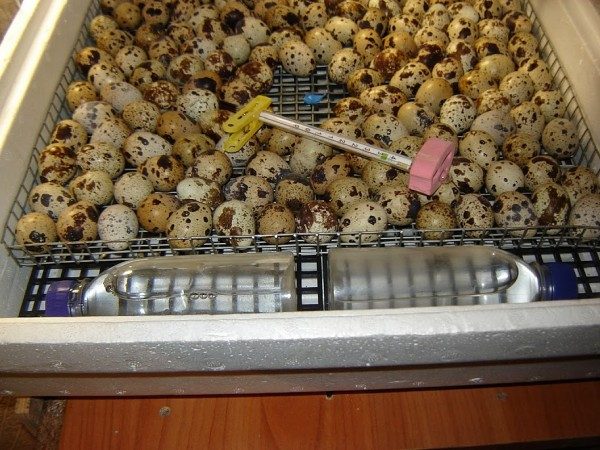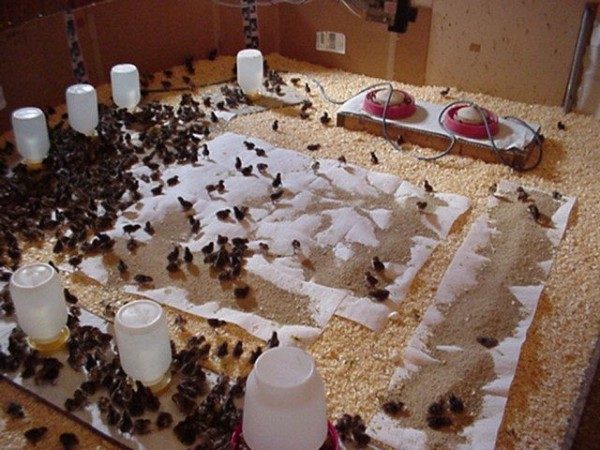Breed quail at home began only 50 years ago. This bird has a lot of advantages, among which: the precocity of individuals, the low cost of eggs, dietary meat and unpretentious content.
In this article we will talk about the features of incubating quail eggs at home, consider the quail incubation table, talk about modes and learn how to lay eggs in an incubator.
Table of contents
What incubators are needed to breed chicks?
Quails have lost the incubation instinct, therefore the hatching of young stock is due to incubators. One of the best and most popular models in Russia is the “Mouth” model.
Made from extruded foam, the incubator weighs 16 kg and has standard dimensions: 70x50x40 cm. The whole body is lined with plastic, on top there is a cover with an electrical cable. In case of removing the cover, the entire apparatus is automatically shut off. Equipped with a removable tray device that turns the eggs every 40-60 minutes.
The rotation function at the time of hatching can be turned off. Under the tray itself there are incandescent lamps, which provide a constant temperature regime, uniformly heating the incubator. You can set the temperature in the range of 25 - 40 ° C. The value is maintained automatically by an electronic thermostat. Provided fire protection.
Humidity is maintained due to the evaporation of water from 2 tanks, which are located above the heater. There are special openings at the bottom and in the lid of the incubator that perform the role of ventilation.
Model "Hatch" will not only bring the young, but also contain quail in it, for 2 weeks. To do this, instead of the tray, the drawer is installed and the growing mode is activated.

How to choose quail eggs
There are a number of options for quail eggs.
- Weight.
• 10-15 grams - for breeding birds;
• 8-13 grams - for birds for meat. - Smooth shell surface, without any flaws: growths, dents, notches, cracks.
- The form. The percentage of a smaller diameter to a larger one is 65 to 70.
- Matte coating.
Each egg should be scanned through the device - an ovoscope. You can use a flashlight for the "light". Look carefully at the egg for flaws: the location and size of the air chamber, the presence of blood inclusions, mixed protein and yolk.
For good hatchability of quail, the incubation egg should not be more than 10 days. Storage temperature - 10-15 ° C.
What humidity should be?
When storing eggs, you should keep the air humidity within 80%.
When incubated for the first 15 days, this value varies between 53-60%. On the 16th and 17th day, the humidity is reduced to 47-49%. During the hatching of chicks, the value is increased to 65-90%.
Humidity is the main indicator during the incubation of eggs. Since the beginning of the development of the embryo, metabolic processes occur. It is necessary to regulate the humidity index in order to avoid embryo water starvation.
If the humidity in the incubator, on the contrary, is too high, a similar situation may arise with the damned shell, since the germinal envelope will be supersaturated with moisture.
Dampness in the incubator can cause mold and fungi in the tray.. Bacterial diseases can be transmitted to the embryo.
To increase humidity during the withdrawal, install containers with warm water to the bottom of the incubator.
You will also be interested in:
- Incubation of turkey eggs.
- Manual for domestic incubator "Layer": how to apply.
- Correct duck egg incubation at home.

Temperature table for incubation period
And now let's talk about what temperature should be in an incubator for quail eggs. Quails are more resistant to overheating or power outages.
When shutting down the incubator, quickly remove the tray from the housing and cool the eggs to 15-18 degrees. As soon as the problem is solved, bring the temperature to the desired value, and put the tray back. With such interruptions, the embryos may linger a little in development.
The first 12 days, the temperature in the quail incubator should be constant - 37.7 ° C. From 13 to 15 days - 37.3-37.5 ° С. During quail removal, the temperature is lowered to 37.2 ° C.
Below is a table of incubation of quail eggs.
| Specifications | Incubator for 50 eggs 220 / 12V (quail.) | Incubator "Layer" for 77 eggs 220 V | Incubator "Neptune" for 80 eggs 220 V | Incubator "Birdie" 60 eggs 220 V |
| Type of thermostat | digital | digital | analog | digital |
| Number of eggs, pieces | 50 | 77 | 80 | 60 |
| Accuracy of temperature maintenance, ° С | ± 0,2 | ±0,1 | ± 0,5 | ± 0,2 |
| Power consumption, W | 40/25 | 40 | 42 | 70 |
| Sizes, mm | 470 x 470 x 235 | 720 x 520 x 290 | 796 x 610 x 236 | 620 x 480 x 260 |
| Weight, kg | 4 | 2,4 | 4 | 6,5 |
| Coup | automatic, every 1 hour (up to four hours) | auto | automatic, 7 times a day | automatic, every 50 min |
| Thermometer | not | electronic, built-in thermostat | analog | electronic, built-in thermostat |
| Humidity measuring device | not | not | not | not |
Bookmark quail eggs: how much time is needed for breeding
For incubation take eggs that are not more than 7 days. The longer the storage period, the less chance of a normal and viable chick being taken out of it.
Bookmark is strictly vertical, the sharp end is located to the bottom of the tray. After they have been laid, they should be disinfected. To do this, use the outside emitter at a distance of 0.4-0.45 m (6-7 minutes).
To increase the shelf life of eggs, you should put the eggs just laid, in boxes with cells, and pack them in a bag, completely closed. You can store them for 15 days at a temperature of about 17 degrees. To increase the shelf life of up to 20 days, you can put the eggs in the incubator every day for 30 minutes.

Conditions for home quail incubation
Many factors influence the quality of hatching of chicks, including the type of feeding, the density of the birds, the age of quails, and the sex ratio.
The most optimal number of quail: 1 male to 4-5 females. Some manufacturers prefer to separate each pair for mating. This significantly increases the percentage of fertilized eggs than with free mating.
Eggs are taken from females aged 2-8 months. In younger females, they are used as food.If a quail is older than 9 months, its egg production does not change, however, the percentage of fertilized eggs decreases.
Males are used as producers, a little longer.
Features and temperature regimes of incubation
And now consider how much time chicks hatch and what needs to be done to do this. Poultry farmers use different modes of incubation.
The first 15 days are required to maintain an optimal mode of 37-38 degrees. Many poultry farmers adhere to other parameters of 36.8-37.6 degrees. For hatching, the temperature varies between 37-37.4 degrees.
Every day should be spraying (2 times / day). Do not forget to air the incubator for 10 minutes. This will help the shell to soften, with the result that the chick will be able to easily peck the shell during the hatching. There is an increase in the percentage of hatchability to 95%.
Egg flipping per day occurs 4-8 times. There are incubators with an automatic coup, but some require manual turning of the eggs. If we neglect the procedure, the chick will stick to one of the inner walls, the chance to survive such an embryo is 0.
Once a day, it is desirable to change the trays in places in a circle.That will allow the eggs to warm up evenly and hatch chicks at the same time, and not with a difference of two days.
If you follow these simple rules, the withdrawal of chicks will occur at 17 days and will last for 6-9 hours.

The reasons for the unsuccessful withdrawal of quails
There are a lot of factors that are causes of a small percentage of hatching. Main reasons.
- Feeding quail. If the diet of birds does not contain vitamins and minerals, and the diet is unbalanced, as a result, preterm or weak embryos with pathologies and defects are born. These chicks cannot pierce the shell with their beak. Such quails die within 1-2 months.
- Disruption of incubation. This is a common cause of failure. By the end of incubation, the embryos need enough oxygen and constant airing of the room from carbon dioxide. As a result of this, the embryos die from suffocation.
- Violation of gas exchange. In such a case, the head of the embryo is located in the direction of the sharp end.The reason for the violation lies in overheating. You should carefully observe the temperature in the incubator and sometimes cool the eggs.
- Turning eggs. Lack of or improper overturning is also a common cause. Protein is used in an incomplete amount, due to which the embryo develops unevenly, or dies after hatching.
Each poultry farmer is obliged to familiarize himself with a number of rules for the proper breeding of quails. You should initially select an incubator based on specifications and additional features. (modes of operation, the turning of eggs, the presence of a box for keeping chicks in the first weeks of life, humidity control, etc.).
It is better to buy eggs from a trusted manufacturer, which has long established itself in the market. However, everyone will be able to try their hand at breeding their own broodstock. This will help save money and gain experience.
As you can see, the withdrawal of quails in an incubator at home is a painstaking procedure that requires patience and perseverance.

Hello, I really liked your article.In the near future I plan to start breeding birds in this regard, I have a question for you about the incubator. What to do when there is a power outage, is there a built-in battery, and if so, on which models? I will be grateful for the answer